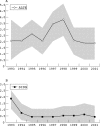Epidemiology of apparent life threatening events
- PMID: 15723922
- PMCID: PMC1720328
- DOI: 10.1136/adc.2004.049452
Epidemiology of apparent life threatening events
Abstract
Aims: To investigate the epidemiology and risk factors of apparent life threatening events (ALTE).
Methods: A prospective study enrolled all live-born infants in the Tyrol (1993-2001). Information on pregnancy, sociodemographic characteristics, child care practices, and infant's behaviour in the first four to six weeks of life was collected with a standardised questionnaire, and was available for 44,184 infants. ALTE was identified from hospital admission records.
Results: During the study period 164 ALTE cases were identified, corresponding to an incidence of 2.46/1000 live births. In 73 of these infants no cause for the event and no comorbidity could be found (idiopathic ALTE). On average ALTE manifested ten weeks earlier than SIDS. Of various SIDS risk factors in the survey area, the prone sleeping position, smoking during pregnancy, low gestational age, profuse night sweating, and family history of infant death showed a moderate relation to the risk of overall ALTE, but only smoking maintained significance in the multivariate risk model. None of these variables was associated with idiopathic ALTE. In contrast to SIDS the frequency of ALTE did not change during the study period. None of the ALTE infants experienced SIDS later in life. Behavioural abnormalities such as feeding difficulties, episodes of pallor, cyanotic episodes, and repeated apnoea episodes were strongly associated with an increased risk of overall and idiopathic ALTE.
Conclusions: Although there are some similarities in the clinical presentation and epidemiology of SIDS and ALTE, differences clearly predominate. Accordingly, ALTE and SIDS should not be considered different manifestations of the same disease process.
Figures
References
MeSH terms
LinkOut - more resources
Full Text Sources
Medical


